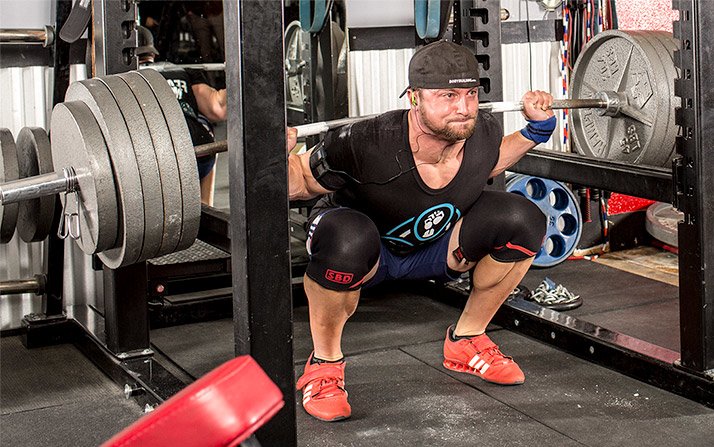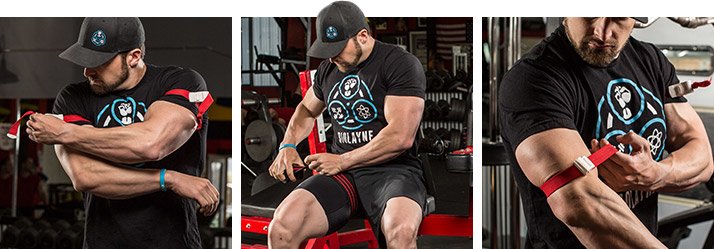
Look Strong, Lift Strong: Layne Norton's Legs And Arms Blast
Pop quiz: Size or strength? For raw elite powerlifter and natural bodybuilder Layne Norton, the answer is both. Try this innovative workout to build oak-strong legs and massive arms!
I'm a powerlifter and bodybuilder. When I go to the gym, I want to make my big lifts bigger and add size with some hypertrophy work. If you're interested in being strong and looking strong, I'll show you how to accomplish both goals in a single workout—without spending hours in the gym.
For this workout, you'll start with one of the "big three" lifts—the squat—and then progress into muscle-building accessory work for arms and calves using cluster sets and blood-flow-restriction (BFR) training. These are advanced techniques, and they may sound intimidating, but don't be scared away without giving them a shot. I'll even show you how to do them on video and explain more in this article.
This workout is tough, yes, but it's effective. If you have multiple goals—like getting as big and strong as possible, as fast as possible—it's going to help you reach them. The template is also extremely versatile and can be used with any of the "big three" lifts. If you want to repeat the session for other body parts, you can simply implement the deadlift or bench instead of the squat, and then incorporate accessory work of your choice for other body parts like your back, delts, or chest.
Layne's Legs and Arms Blast
Squat Heavy
Even if you're not a powerlifter, the barbell squat is one of the best movements for building overall strength and size. It'll challenge your entire lower body and help make your core iron-strong. Because you're following a low-rep scheme, you should be moving some pretty heavy weight on this exercise.
There's nothing magical about doing 4 sets of 6 on squats; I like this rep range because it allows you to use heavy weights and still get quite a bit of volume in. I encourage using a variety of rep ranges as part of a properly periodized training program.
Don't just get into the rack and start squatting. Think about what you're going to do. Think about how you're going to do it. If you have a squat ritual, follow it. Each set should be a concentrated effort.
I like to take 5-10 minutes of rest between each set. A lot of people believe that increasing your rest period cuts down on muscle stimulation, but that's not really the case. The time your muscles spend under tension is cumulative, so even though I take a fair amount of rest, my muscles get plenty of time under tension (TUT) to grow. Moreover, by taking longer rest periods, I can give max effort to each set and lift near-max weight.
There are definitely benefits to using less rest, but if you decide to do that, you'll have to use lighter weight. If you're simply a little afraid to lift heavy and want more coaching on the best ways to perform the squat for your body type, check out my squat tutorial article.

Cluster training
Cluster training may seem a little complicated, but it's a great way to get in a lot of reps without spending too much time working. In a cluster set, you break up a traditional set with short, intra-set breaks. This allows you to lift more than you'd be able to otherwise at the same amount of volume.
For each exercise after the squat, you'll perform two cluster sets and rest 1-2 minutes between clusters. Each cluster set contains 4 "mini sets" of 30, 15, 15, and 15 reps each. Rest 30 seconds between each of these sets.
1 cluster = 4 sets of 30, 15, 15, 15 reps (rest 30 seconds between each set)
BFR
In addition to using cluster sets with these exercises, you'll also employ blood-flow-restriction training, in which you wrap your appendages with a knee, wrist, or other wrap to restrict blood flow to the veins, not the arteries. This restriction causes an increase in cell swelling that may help you build more muscle!
I like to use BFR because it allows me to get a lot of volume and muscle stimulation without taxing my joints too much or detracting from my main lifts. BFR using low-intensity resistance may be just as effective at increasing strength and hypertrophy compared to traditional hypertrophy training.
I find BFR helpful because, after a heavy lifting session, I can get the same hypertrophy results without using heavy weight. This puts less strain on my joints and nervous system, making it easier for me to recover and get back in the gym.
BFR may sound dangerous, but research indicates that it's completely safe when done correctly. The most important thing is to not wrap too tightly. If you're in pain before the exercise starts, or you feel any numbness or tingling, the wraps are too tight. It's normal to be in discomfort during the exercise, but you shouldn't be in pain beforehand.
If you can't complete the sets and reps, either the weight is too heavy or the wraps are too tight. The point is to go light because you don't have to use heavy weights to get growth with BFR.

Wrap It Up
When using BFR with these cluster sets, I like to keep the wraps or cuffs on for the whole cluster. When I finish one cluster, I take the wraps off, rest, and then rewrap.
No matter what muscle you're training, wrap at the proximal (upper part) of your arms and legs. Even when you're training your calves, you're going to wrap as high on your leg as you can. This basically means you should wrap under your shoulder and high on your inner thigh.
I prefer using a small cuff when I'm training my biceps and triceps. For lower body, you can use a knee wrap or other large band.
When utilizing BFR, select a weight that's about 20 percent of your one-rep max. Don't go as heavy as you can! You want high reps and volume here, not weight
Wrap to about a 7/10 tightness level on your legs and 9/10 on arms. Keep in mind that you don't want to occlude blood flow entirely. You want to get blood into the working muscle without letting in leave. If you're ever in pain before the exercise or can't finish the reps, the wraps are probably too tight or the weight is too heavy.
You'll notice that by the end of a cluster set, you're going to have a ridiculous pump. It's awesome, but it's also going to be painful. Part of the challenge of utilizing BFR is increasing your pain tolerance.
Make your sets consistent. If one takes you much less time than the others, it may mean that you're rushing. Take your time through each set. As you go through the set, you'll feel your heart rate go up, but that's normal. Your heart is working harder to circulate that blood through the restriction.
Go lift!
Now it's time to get into the gym and try some of these things yourself! If you have any questions, hit me up in the comments section below.

